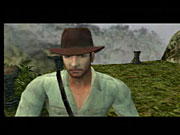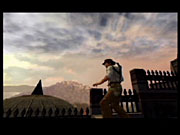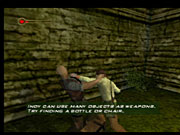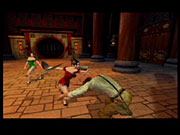When Tomb Raider first hit the scene back in 1996, it was easy to describe the game's premise as an Indiana Jones movie with a female lead. Lara Croft spent the next several years cornering the market on the video game version of action archeology, and even though the comparisons to Harrison Ford's big-screen character never really stopped completely, it took LucasArts four years to strike back with Indiana Jones and the Infernal Machine, a flawed game for the PC and the Nintendo 64. Now, LucasArts is giving its whip-cracking action hero another shot at the title with Indiana Jones and the Emperor's Tomb, which was developed by The Collective. While the game does a lot of things right, severe graphical issues surface at almost every turn and essentially nullify its strong points, leaving behind a game with lots of untapped potential.

Emperor's Tomb takes place in 1935 and puts the rough-and-ready archeologist on a quest to recover a Chinese artifact known as the Heart of the Dragon--a black pearl with the power to control minds. In keeping with the standard Indiana Jones formula, our good doctor isn't the only party involved in the quest, and along the way you'll encounter plenty of Nazi thugs and Chinese gang members, all of whom want the pearl for their own evil uses. Though the plot contains a few twists and double crosses, the game is very thin on storytelling, only breaking into a cutscene to move you from one part of the world to another. Even the mission objectives aren't expressly conveyed outside of the pause screen, though the linear nature of the level design doesn't often force you to know exactly what you're after at any given time, anyway. While the game is pretty straightforward, it does throw a lot of different levels at you, moving through a number of different locales along the way--you'll travel to Prague, Istanbul, Hong Kong, an island fortress, and more. Even though you'll be moving along from place to place fairly quickly, it doesn't feel like a short game, and players should be able to get a little more than 10 hours out of it. There isn't much replay value to speak of, of course, though the game does contain three difficulty settings and a handful of optional artifacts that are hidden throughout the levels.

The game combines the exploration and third-person maneuvering of Tomb Raider with a simplified version of the combat system found in The Collective's last game, the well-received Buffy the Vampire Slayer. Indy runs on a modified and ported version of the Buffy engine, and you can perform most of the running- and jumping-related maneuvers you'd expect to in a third-person action game. At first, the control feels a little too loose--it's easy to miss jumps if you're sloppy with the controls--but after some time, moving Dr. Jones around becomes second nature. You'll often find yourself having to use Indy's bullwhip to swing from one platform to another. The game always lets you know where, exactly, you'll need to do this by bringing a whip icon up on the screen when you're in position. Similarly, you'll see a knife icon when it's time to hack through thick vines, a switch icon when there's something for you to pull, and an explosion icon when you're near a spot that requires you to plant explosives. When any of these icons are up, an inventory button lets you quickly yank out the necessary item. While this helps make the game a lot easier than it would have been without them, at other times the occasionally unclear level design and nasty, blurry textures obscure some things that you'd otherwise need to see for yourself in order to proceed.
While you'll spend most of your time in the game running around and climbing up and over platforms, there is also quite a bit of combat to be found. While the combat isn't terribly deep, it still can be satisfying. Indy's punches and kicks are exaggerated, giving you the impression that he's really beating the hell out of his foes. He has a good variety of dirty moves in his arsenal, and a combo system lets you string attacks together.
Your whip comes into play during combat as well. Normally, you just whip people, but if you get the distance between you and your target down right, you can whip weapons out of enemies' hands or even wrap the whip around a foe's neck and drag him over to you, Scorpion-style, for a quick left to the face. You can also find and use a variety of firearms and makeshift weapons like chairs, and the game even has a grappling system that lets you get in a few cheap punches or shove people up against walls--or over the edges of cliffs, where you'll hear them go screaming down to their doom.

With its satisfying combat system and straightforward exploration elements, Indiana Jones definitely has the mechanics to be a cool game. It's this potential that makes the game's crippling graphical problems so disappointing. The lack of polish in the game makes it seem unfinished and ranges from plainly obvious clipping and collision problems to a wildly fluctuating frame rate that bounces from only slightly choppy to what feels like a near halt. On top of all that, the entire game is extremely blurry. At times the game is so blurry that you might start to wonder if your PS2's video cables are going bad or if perhaps someone snuck into your house and smeared butter all over your TV screen.

The game's sound does a good job of emulating the music from the Indiana Jones movies. The soundalike used for Indiana Jones himself does a convincing enough job of sounding like Harrison Ford's take on the character, but you probably won't ever mistake the stand-in for the real deal. Some of the other voices don't fare so well. The standard enemy voices get repetitive, and some of the accents--Mei Ying's Chinese accent, for example--sound pretty bad.
The good parts of Indiana Jones and the Emperor's Tomb offer a glimpse of what could have been, but the PS2 version of this game pales in comparison with even the buggy Xbox release. You can definitely see a great game hidden in the finished product, but calling the Emperor's Tomb "finished" doesn't seem right. There's definitely some fun to be had here, and Indiana Jones fans will likely appreciate the way their favorite archeologist is represented in the game, but the shoddy translation of this Xbox game to the PlayStation 2 makes the end result seem pretty unplayable.